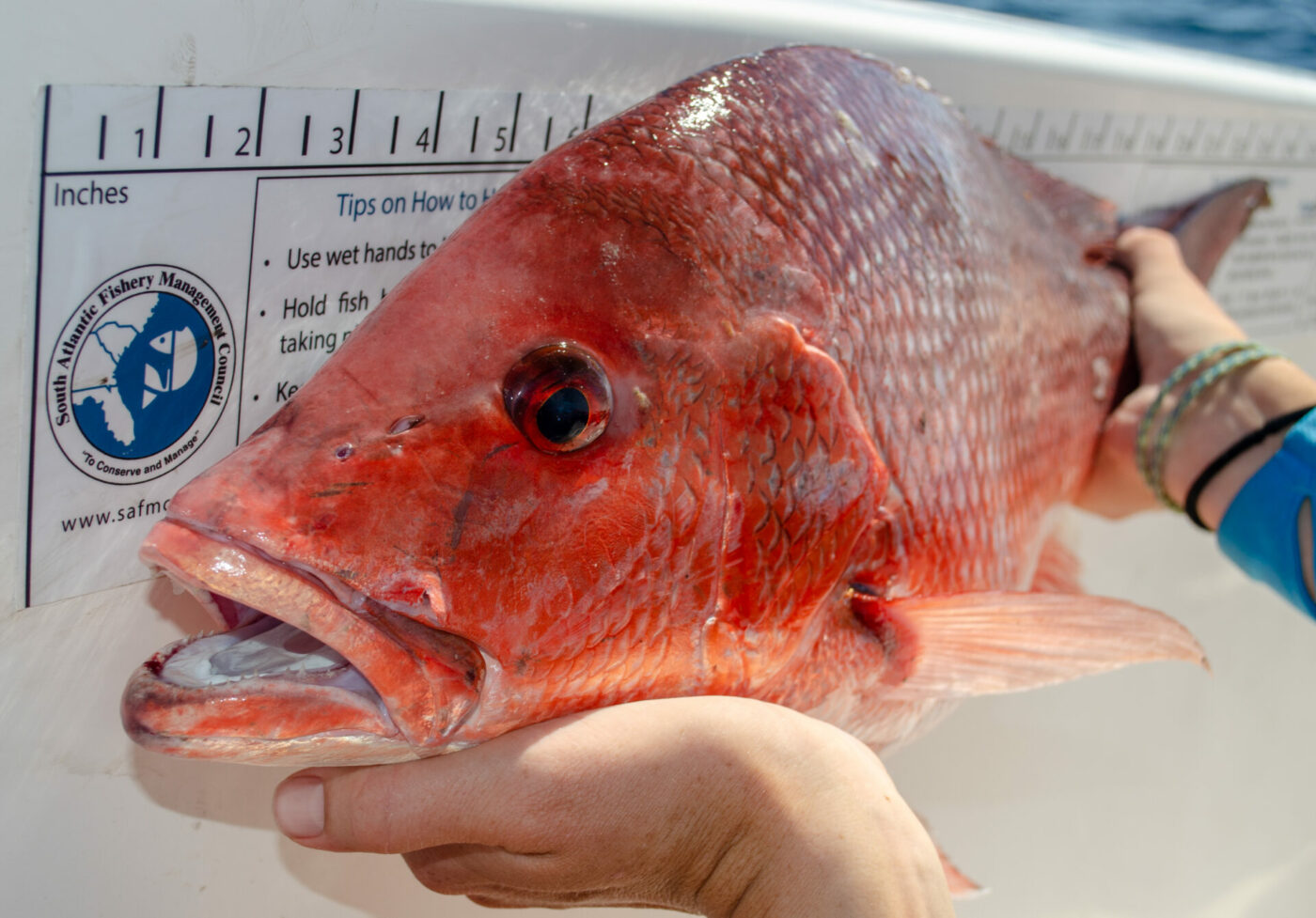Federal Fishery Managers Consider Options for Red Snapper Management

There were many agenda items affecting federal fisheries management for the September meeting of the South Atlantic Fishery Management Council, but a single issue dominated interest from the public – the potential use of time/area closures for the snapper grouper fishery. The Council received a total of 1,047 online written comments, with the majority opposing time and area closures to address release mortality in the Red Snapper fishery. The opposition continued as the Council received comments during the meeting in Charleston, SC from charter captains, recreational fishermen, regional business leaders, boat and fishing gear manufacturers, and Florida Congressman John Rutherford.
Managing Red Snapper as the stock continues to rebuild remains a challenge. As the number of Red Snapper increases, so does the number of fish released that die, driven primarily by the recreational sector targeting co-occurring snapper grouper species. Frustration levels also are also high because the stock remains listed as “undergoing overfishing” due to release mortality and its impacts on the larger breeding populations. As a result, harvest remains strictly limited.
During its June 2022 meeting, the Council requested a comprehensive list of data analyses to consider options for time/area closures to address release mortality as it develops Regulatory Amendment 35 to the Snapper Grouper Fishery Management Plan. The draft amendment currently includes an action to reduce the Acceptable Biological Catch (ABC) and Annual Catch Limits (ACL) for Red Snapper to address overfishing as required, and options to reduce release mortality by allowing only single hook rigs and prohibiting the use of automatic (electric) reels in the recreational snapper grouper fishery. “You still have year-round access to the Red Snapper fishery,” said NOAA Fisheries Regional Administrator Andy Strelcheck during a presentation at the meeting. “While the Council is taking positive steps to reduce release mortality, more has to be done. There’s a changing baseline – drivers 10-20 years ago are different than today,” explained Strelchek, noting the increase in the numbers of offshore recreational fishermen, access to highly improved electronics, and other factors.

After considering public input, data concerns, and the need for additional analyses, Council members were quick to oppose considering area closures in Regulatory Amendment 35 and discussed options for addressing management through short-term, mid-term, and long-term solutions. The Council agreed to move forward with the amendment, considered a “short-term” measure to immediately address the overfishing condition, until additional mid-term and long-term management measures could be considered and put into place.
Regulatory Amendment 35 includes an outreach component, stressing the importance of best fishing practices in improving the survivability of all snapper grouper species. “Recreational fishermen can certainly do their part in reducing release mortality,” said Council Chair Mel Bell during discussions. “We’ve heard from business and industry leaders and will depend on their support as we move forward. If you educate fishermen, I think they will do the right thing. I’ve watched this happen at the state level with amazing results.”
The Council’s Snapper Grouper Advisory Panel will provide recommendations during its October 18-20 meeting in Charleston. Regulatory Amendment 35 is scheduled for approval during the Council’s March 2023 meeting, with public hearings anticipated in early 2023.
Other Actions
Greater Amberjack (Snapper Grouper Amendment 49)
The Council approved Snapper Grouper Amendment 49 for submission to the Secretary of Commerce during their meeting. The amendment addresses changes in management for Greater Amberjack after the latest assessment, completed in 2020, indicated the stock is not overfished or undergoing overfishing. If approved by the Secretary of Commerce, the amendment would: increase the Annual Catch Limit (ACL); revise sector allocations with 65% of the total ACL recreational and 35% commercial; reduce the commercial minimum size limit from 36” fork length to 34” fork length (the recreational minimal size limit is 28” fork length); increase the commercial trip limit during Season 2 (September 1 through end of February) to 1,200 pounds gutted or whole weight; apply the current April spawning season closure to both commercial and recreational fishermen; and remove recreational annual catch targets from the Snapper Grouper Fishery Management Plan. The amendment would also adopt revised goals and objectives for the Snapper Grouper Fishery Management Plan.

Spanish Mackerel
The recent stock assessment for Spanish Mackerel was reviewed by the Council’s Scientific and Statistical Committee in August 2022. The SSC had numerous concerns with the assessment and input data, such as the recent recreational estimates from NOAA Fisheries Marine Recreational Information Program (MRIP) and concluded that additional work was needed before the assessment could be accepted. New landings will be incorporated into the stock assessment model to address the uncertainty and the Council’s Scientific and Statistical Committee will review the outcomes during its October 25-27, 2022 meeting. The Council’s Mackerel Cobia Advisory Panel will also provide input on increased recreational shore-based landings and overall increase in recreational effort during the COVID-19 pandemic, effects of a lower commercial trip limit on market price, and other fishery issues during its October 5-6, 2022 meeting in Charleston.

Elections
The Council elected Dr. Carolyn Belcher to serve as its new Chair. Dr. Belcher is the Council representative for the GA Department of Natural Resources and is currently the Chief of Fisheries for the Coastal Resources Division. She was serving as Vice Chair when elected to replace Mel Bell with the SC Department of Natural Resources as Chair. Trish Murphey, the agency designee for the NC Division of Marine Fisheries was elected Vice Chair.
Information about the September Council meeting, including final committee reports, public comments, and meeting materials is available from the Council’s website at: https://safmc.net/events/september-2022-council-meeting/. The next meeting of the Council is scheduled for December 5-9, 2022 in Wrightsville Beach, NC.